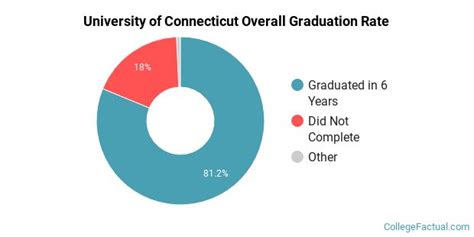Introduction
The University of Connecticut (UConn) is a public research university with a student population of over 30,000. As one of the largest universities in the United States, UConn is committed to providing its students with a high-quality education. One of the key indicators of a university’s quality is its graduation rate.

In this article, we will take a comprehensive look at UConn’s graduation rates. We will examine the overall graduation rate, as well as the graduation rates for different student groups. We will also discuss the factors that affect graduation rates and provide tips for students who want to improve their chances of graduating on time.
UConn’s Overall Graduation Rate
According to data from the National Center for Education Statistics (NCES), UConn’s overall graduation rate for first-time, full-time students who began their studies in the fall of 2016 was 76%. This is higher than the national average for public universities, which is 60%.
However, it is important to note that graduation rates can vary significantly depending on the student population. For example, the graduation rate for white students at UConn is 82%, while the graduation rate for black students is 59%.
UConn’s Graduation Rates for Different Student Groups
The following table shows the graduation rates for different student groups at UConn:
| Student Group | Graduation Rate |
|---|---|
| White students | 82% |
| Black students | 59% |
| Hispanic students | 62% |
| Asian students | 86% |
| Native American students | 52% |
| International students | 71% |
| First-generation college students | 67% |
| Student-athletes | 73% |
| Students with disabilities | 61% |
As you can see from the table, there are significant disparities in graduation rates for different student groups. These disparities are due to a variety of factors, including socioeconomic status, academic preparation, and access to support services.
Factors That Affect Graduation Rates
There are a number of factors that can affect graduation rates. Some of these factors are within the control of students, while others are not.
Factors Within Students’ Control
- Academic preparation: Students who enter college with a strong academic foundation are more likely to succeed in college. This means taking challenging courses in high school and earning good grades.
- Study habits: Good study habits are essential for success in college. Students who study regularly, take notes, and review their material are more likely to do well in their classes.
- Time management: Time management skills are important for success in college. Students who are able to manage their time effectively are more likely to stay on track and graduate on time.
- Motivation: Motivation is key to success in college. Students who are motivated to learn and achieve are more likely to put in the effort needed to succeed.
Factors Outside Students’ Control
- Socioeconomic status: Students from low-income families are more likely to face challenges in college. These challenges include food insecurity, housing insecurity, and lack of access to healthcare.
- Academic preparation: Students who come from under-resourced schools may not have the same academic preparation as students from more affluent schools. This can make it difficult for them to succeed in college.
- Access to support services: Students who have access to support services, such as tutoring, counseling, and financial aid, are more likely to succeed in college.
Tips for Improving Graduation Rates
There are a number of things that students can do to improve their chances of graduating on time.
- Set realistic goals. Don’t try to take on too much at once. Set realistic goals and work towards them gradually.
- Make a plan. Once you have set your goals, make a plan to achieve them. This plan should include a study schedule, a time management plan, and a plan for accessing support services.
- Get involved on campus. Get involved in extracurricular activities, such as clubs, sports, and student government. This will help you connect with other students and build a sense of community.
- Seek support. If you are struggling in college, don’t be afraid to seek support. There are a number of resources available to help you, such as tutoring, counseling, and financial aid.
Conclusion
Graduation rates are an important indicator of a university’s quality. UConn’s graduation rates are higher than the national average, but there are still some disparities in graduation rates for different student groups. There are a number of factors that can affect graduation rates, both within and outside students’ control. Students can improve their chances of graduating on time by setting realistic goals, making a plan, getting involved on campus, and seeking support.
